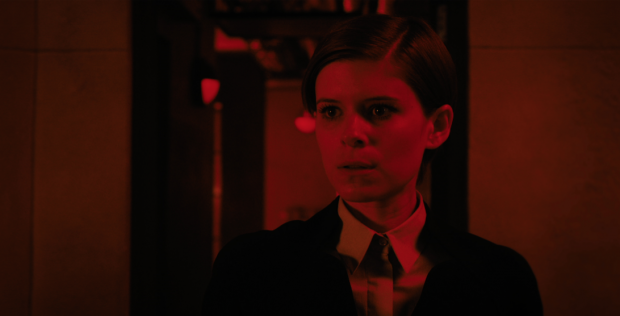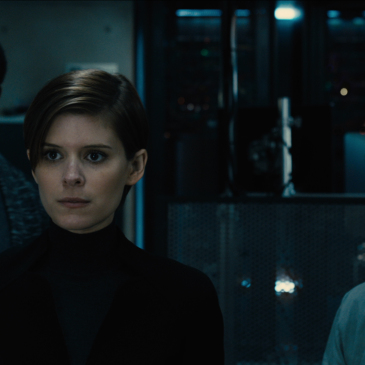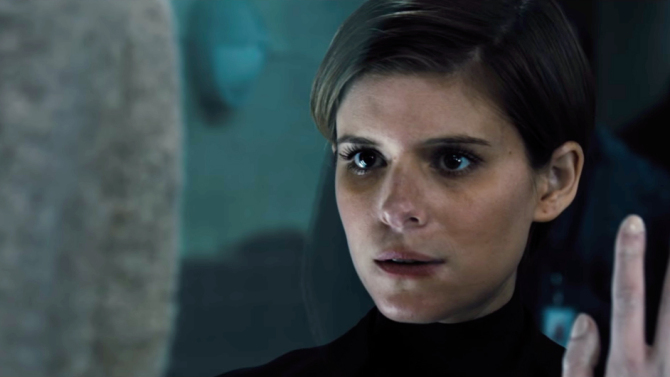A humanoid girl bred from synthetic DNA is the fatal attraction of a derivative sci-fi movie that doesn’t know what to do with her.
Robots, supercomputers, automatons: The history of sci-fi can be boiled down to a laundry list of humanoid machines whose very existence raises the question, “Yes, but do they have feelings?” The title character of “Morgan” is, in many ways, a successor to all those spooky-chilly faux-human techno marvels. Except that Morgan does have feelings. She’s not a replicant built out of diodes and synthetic skin; she was bred — and born — in a lab out of synthetic DNA. She’s a not-so-far-fetched version of a “human” being who emerges out of the era of cloning and the corporate obsession with genetic modification.
Anya Taylor-Joy, the actress who plays her, was 19 when “Morgan” was shot, but she looks much younger, and though she does have eyebrows, they barely register. All you notice, under Morgan’s gray hoodie, is her luminous ghostly pallor, her upper lip cut like an “M,” and the startling intensity of her oversized dark almond eyes, which recall the image of extraterrestrials from the ’70s. She may on some level be human, but she is every inch a creature.
The movie is a sci-fi potboiler that starts off by fostering some genuine interest in a character who seems to express something of her moment. Morgan, who’s technically just 5 years old (though far smarter and stronger than her years), is a corporate experiment who has grown up in a glassed-in concrete bunker. The film opens with an explosive scene in which she’s told, by one of her guardians (Jennifer Jason Leigh), that they’re going to have to cut back on the time she spends outdoors — time that Morgan values with so much emotion that she reacts to the news by leaping out of her chair and trying to claw the guardian’s eye out. So here’s the rub: Morgan has feelings, but she also has a highly overdeveloped (or maybe just uncontrolled) id. She’ll stare down an interviewer across the table with a look to kill, and then she’ll attempt to make good on it; she can glare into a surveillance camera and let the person watching feel as if she’s looking right back at them. In her cell, she sits in her sweatshirt, listening to classical music, a sulky figure of hovering brilliance and menace, like Dr. Lecter crossed with Negasonic Teenage Warhead.
The person who’s been assigned to determine Morgan’s fate is Lee Weathers (Kate Mara), a risk-management consultant with a mysterious agenda. It’s part of the way the movie works that as soon as we see Mara, with her fastidious slick clipped hair and steely eyes, as well as a manner so professionally cold and rigid that she makes her sister Rooney look like Sarah Silverman, it’s hard not to notice that Lee seems to share a certain spirit with Morgan, even though she’s basically been brought in to shut her down.
The others are a team of hipster scientists who have been secluded, for seven years, in a top-secret mansion headquarters that resembles a bombed-out Wayne Manor, located on the edge of a woods that looks like it could be the setting for a remote summer camp. There, they’ve raised Morgan and become her wary family. They tend to think of her as a real person, whereas Lee hews to the company line that Morgan should be referred to as “it” (which seems a bit extreme, given that even ocean liners are called “she”). The hang-loose team, the members of which live like drunken bohemians in Portland, include Toby Jones as the head scientist, Michelle Yeoh as Morgan’s stern lab-coated “mother,” and Rose Leslie as her vivacious behaviorist BFF. All of them remain loyal to her, even after Morgan gets interviewed by a smug psychiatric evaluator (Paul Giamatti) whose driving motivation seems to be to prove that he’s superior to her. By the time he’s done goading her, she has made mincemeat of him.
“Morgan” is linked, in theme and design, to last year’s “Ex Machina,” which also told the story of an eerie lifelike humanoid experiment locked away inside a corporate woodland bunker. But the highly creepy originality of that film, apart from its eye-popping flesh-meets-metallurgic-skeleton effects, is that it wasn’t just about whether the robot in question had feelings or not. It was about the compulsive need of everyone around her, especially the men, to believe that she had feelings. “Morgan” is the first feature directed by Luke Scott, the son of Ridley Scott (who serves as one of the producers), and it’s little more than a schlock replay of “Ex Machina.” It toys around with some of the same situations, but it doesn’t know where to take them. Instead of developing its themes, it uses them as grist for an overload of “commercial” action.
“Morgan” isn’t a movie that should be climaxing with fistfights, yet by the time Morgan gets out in the woods again, trying to escape Lee, the efficiency expert-turned-company assassin, she’s become the tween Hannibal Lecter meets Jason Bourne. It’s all to set up the film’s big kicker of a twist (in a scene that features the original big-screen Lecter, Brian Cox). “Morgan,” in the end, takes enough overwrought and even ridiculous turns to seriously compromise its chance of finding an audience. Yet there are a few moments when something in the movie strikes a chord. All science fiction is metaphor, and a thriller about a hellion ingenue with a dead stare who is really a thing but has feelings anyway, and will kill you if you threaten to take them away, is expressing something about the state of girlhood today. If only it could figure out what.

